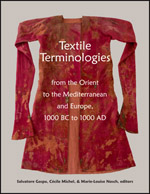Center, Textile Research

Textile Terminologies from the Orient to the Mediterranean and Europe, 1000 BC to 1000 AD
Date of this Version
2017
Document Type
Article
Citation
In Textile Terminologies from the Orient to the Mediterranean and Europe, 1000 BC to 1000 AD, ed. Salvatore Gaspa, Cécile Michel, & Marie-Louise Nosch (Lincoln, NE: Zea Books, 2017), pp. 278-287.
doi:10.13014/K2FB5136
Abstract
The semantic field of Latin licium and its plural form licia is undoubtedly wide, with the term applied to thread both generally and in specific legal, medical and magical usage as well as in relation to weaving, and this paper does not aim to survey Latin usage of this term comprehensively. Rather, it focuses on one of the uses of licia in Latin literary sources, namely those where licia appears to denote heddle-leashes. Two much-discussed passages occur in Augustan poetry where licia may be used in this sense: Vergil’s Georgics 1.285 and Tibullus elegy 1.6.79. Both passages have been subject to considerable discussion in the past, and in both cases, ambiguity still remains. In the case of sources from late Antiquity, such as the fifth appendix to Claudian’s Carmina minora and Isidorus’ Origines 19.29.7, there is wider agreement that licia is indeed used to describe heddle-leashes, but scholars have hesitated to allow such late evidence influence the interpretation of earlier, poetic passages.
The readings proposed below credit Latin authors with greater technical understanding of weaving than has sometimes been assumed, suggesting that their tacit knowledge of textile production has influenced the artistic presentation of their descriptions of such work in ways hitherto little considered. My readings are heavily influenced by observation of weaving experiments conducted at the Centre for Historical- Archaeological Research and Communication at Lejre by staff from the Centre for Textile Research in Copenhagen and at the Department of Aegean Archaeology in Warsaw, marrying results gained in experimental archaeology to philological analysis. I will show that analysis of the rhythm and soundplay of the relevant passages suggests that even relatively short passages in literary sources carefully and knowledgeably reflect (parts of) historical working processes; this is, as I will indicate, true of early and late sources alike.
Included in
Ancient History, Greek and Roman through Late Antiquity Commons, Art and Materials Conservation Commons, Classical Archaeology and Art History Commons, Classical Literature and Philology Commons, Fiber, Textile, and Weaving Arts Commons, Indo-European Linguistics and Philology Commons, Jewish Studies Commons, Museum Studies Commons, Near Eastern Languages and Societies Commons, Other History of Art, Architecture, and Archaeology Commons


Comments
Copyright © 2017 Salvatore Gaspa, Cécile Michel, & Marie-Louise Nosch. Photographs copyright as noted.